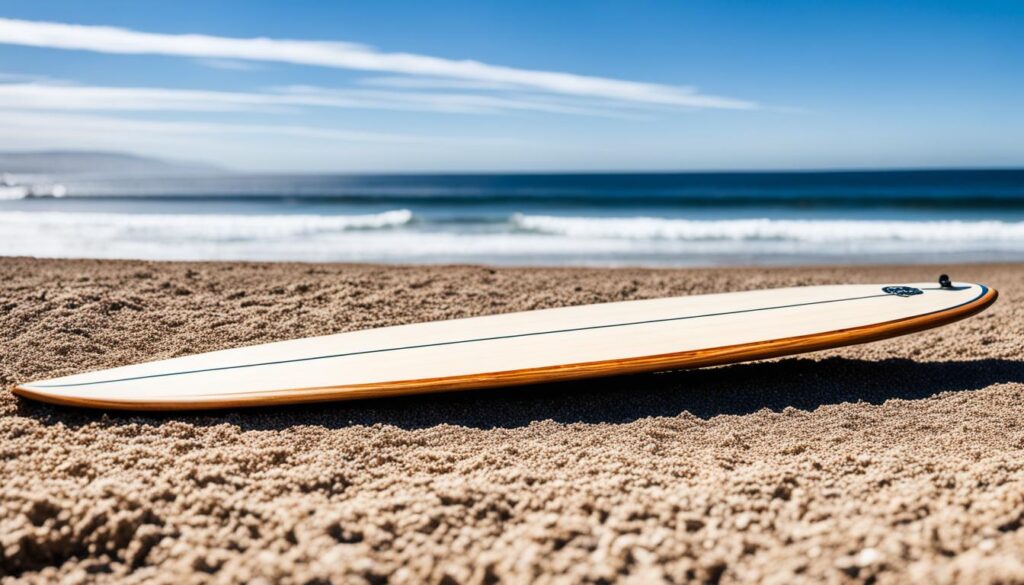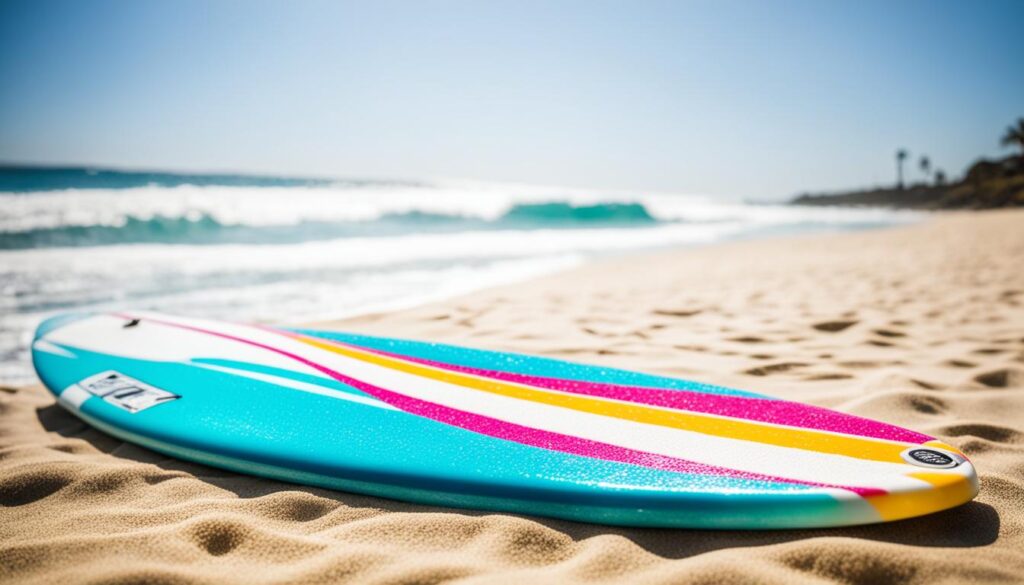When you think of surfboards, what material comes to mind? Many people assume that surfboards are made of plastic, but is that really the case? In this article, we delve into the world of surfboard materials to uncover the truth about their composition. Prepare to be surprised!
Surfboards have been an integral part of the surfing culture for decades, and they have undergone various changes in design and construction. But are traditional plastic materials still the go-to choice for surfboard manufacturers? Or is there a shift towards more sustainable alternatives? Let’s find out!
Key Takeaways
- Surfboards have traditionally been made from plastic materials like polyurethane foam and fiberglass.
- The production and disposal of plastic surfboards have significant environmental impacts.
- Some companies are exploring the use of recycled plastic in surfboard manufacturing.
- Wooden surfboards have gained popularity as a sustainable alternative to plastic.
- Choosing sustainable surfboards benefits the environment and offers excellent performance and durability.
The Use of Plastic in Surfboards
Traditional surfboards are often made from plastic materials, such as polyurethane foam and fiberglass. The manufacturing process involves shaping the foam core, covering it with fiberglass and resin, and then sanding and finishing the board.
However, the production and disposal of plastic surfboards have significant environmental impacts. Plastic production contributes to carbon emissions and pollution, and plastic waste can end up in landfills and oceans, harming marine life.
| Environmental Impact of Plastic Surfboards |
|---|
| Carbon emissions from plastic production |
| Pollution from plastic manufacturing process |
| Plastic waste ending up in landfills and oceans |
| Harm to marine life |
It is important to address these environmental concerns and explore alternative materials and manufacturing processes that minimize the negative impact of surfboard production.
Surfboards Made from Recycled Plastic
As the world grapples with the environmental impact of plastic waste, some surfboard manufacturers have turned to recycled materials as a potential solution. One such alternative is the production of surfboards made from recycled plastic.
The use of recycled plastic in surfboard manufacturing involves transforming ocean plastic waste into new resin, which is then used to create the boards. This innovative approach not only reduces the demand for new plastic production but also helps to tackle the issue of plastic waste, at least in part.
However, it is important to note that while surfboards made from recycled plastic contribute to sustainable surfboard production, they do not completely solve the problem of plastic waste disposal. Eventually, these surfboards will also reach the end of their lifespan and contribute to the overall plastic problem.
Despite this limitation, the production of surfboards from recycled plastic still plays a crucial role in reducing the environmental impact of traditional plastic surfboards. By diverting plastic waste from the ocean and landfills, these recycled plastic surfboards offer an eco-friendly alternative for surfers who are committed to sustainable practices.
| Advantages | Disadvantages |
|---|---|
|
|
Quote:
“Surfboards made from recycled plastic offer a unique opportunity to reduce our reliance on new plastic production while showcasing the potential of recycled materials. However, we must continue to explore more sustainable alternatives to address the larger issue of plastic waste disposal.” – Mark Johnson, Founder of Sustainable Surfboards Co.
While surfboards made from recycled plastic are a step in the right direction, there is still a need for further innovation and research into more sustainable materials and manufacturing processes. The surf industry must continue to invest in eco-friendly surfboard production methods to meet the demands of eco-conscious surfers and ensure a greener future for the sport.
Innovative Materials for Sustainable Surfboards
In response to the environmental concerns associated with traditional plastic surfboards, surfboard manufacturers have been exploring alternative materials to create eco-friendly and plastic-free surfboards. One innovative material that has gained attention is advanced Ultrafuse rPET filament, which is made from recycled medical packaging materials.
The Ultrafuse rPET filament is used to create the internal structure of surfboards, replacing the traditional plastic foam core. This filament is strong, lightweight, and has excellent durability, making it an ideal alternative to plastic foam. The use of recycled medical packaging materials not only reduces waste but also helps to minimize the reliance on new plastic production.
To ensure the surfboards are eco-friendly, the Ultrafuse rPET filament is covered with a layer of biocomposite. The biocomposite is made from sustainable natural materials, such as plant fibers or bio-based resins. This combination of recycled filament and biocomposite creates surfboards that are both durable and sustainable.
Using alternative materials like the Ultrafuse rPET filament and biocomposites allows surfers to enjoy their favorite water sport without harming the environment. These eco-friendly surfboards offer a greener choice for surfers who are passionate about sustainability.
By embracing these innovative materials, surfboard manufacturers are contributing to a more sustainable surf industry. Eco-friendly surfboards not only reduce the environmental impact of surfboard production but also inspire others to prioritize sustainability in their purchasing decisions.
Furthermore, the use of alternative materials for surfboard production encourages continued innovation in the surfing community. As companies discover new eco-friendly materials and manufacturing processes, the future of surfboard production holds the promise of stylish and sustainable boards that align with the values of eco-conscious surfers.
Wooden Surfboards as an Alternative
As the demand for sustainable surfboard materials continues to grow, wooden surfboards have emerged as a popular and eco-friendly alternative to traditional plastic surfboards. Made from invasive tree species such as albizia and balsa, these surfboards not only provide an environmentally conscious solution but also help remove these detrimental species from delicate ecosystems.
Wooden surfboards offer a more natural and aesthetically appealing option for surfers who are looking to reduce their reliance on plastic materials. By embracing wooden surfboards, surfers can minimize the environmental impact associated with plastic surfboard production, including carbon emissions and plastic waste.
Manufacturers are utilizing innovative crafting techniques to create durable and sustainable wooden surfboards. The use of invasive tree species not only offers a sustainable material source but also supports conservation efforts by removing these species from sensitive ecosystems.
Advantages of Wooden Surfboards:
- Environmentally friendly: Wooden surfboards reduce the reliance on plastic materials and contribute to a more sustainable surf industry.
- Aesthetic appeal: The natural grain and unique patterns of wood provide a visually appealing and distinctive surfboard.
- Durability: Properly constructed wooden surfboards can be as durable as their plastic counterparts, offering surfers long-lasting performance.
- Biodegradable: At the end of their life cycle, wooden surfboards are more biodegradable compared to plastic surfboards, reducing their impact on the environment.
Are you interested in a visual representation of the advantages of wooden surfboards?
Check out the table below, which showcases the benefits of wooden surfboards compared to traditional plastic surfboards:
| Advantages | Wooden Surfboards | Plastic Surfboards |
|---|---|---|
| Environmental impact | Minimized reliance on plastic materials | Contribute to plastic pollution and carbon emissions |
| Durability | Comparable to plastic surfboards | May have a shorter lifespan |
| Aesthetic appeal | Natural grain and unique patterns | Uniform and standardized design |
| End-of-life cycle | More biodegradable | Contribute to plastic waste |
With their eco-friendly properties and sustainable sourcing, wooden surfboards provide surfers with a guilt-free and stylish option to ride the waves while minimizing their environmental impact. By opting for wooden surfboards, surfers can support a more sustainable future for both the surf industry and the planet.
Advantages of Wooden Surfboards
When it comes to sustainable surfboards, wooden options have emerged as an attractive alternative to traditional plastic surfboards. These eco-friendly surfboards offer several advantages that make them an excellent choice for environmentally conscious surfers.
- Locally sourced and sustainable materials: Wooden surfboards can be crafted using locally sourced and sustainable materials, such as the albizia tree in Hawaii or the balsa tree in Indonesia. By utilizing these renewable resources, surfboard manufacturers reduce their carbon footprint and support local economies.
- Lower environmental impact: Compared to plastic surfboards, wooden surfboards have a lower environmental impact throughout their lifecycle. The production process involves minimal waste, and additive manufacturing techniques like 3D-printing can be used to create surfboards with precision and minimal material consumption.
- Biodegradable end-of-life cycle: One of the key advantages of wooden surfboards is their biodegradable nature. When a wooden surfboard reaches the end of its lifespan, it naturally decomposes over time, reducing its environmental impact and minimizing waste compared to plastic surfboards.
“Wooden surfboards offer an eco-friendly and sustainable choice for surfers who want to enjoy the waves while minimizing their environmental footprint.”
Wooden surfboards not only offer a more sustainable option but also exude a unique aesthetic appeal. Their natural beauty and craftsmanship make each surfboard a one-of-a-kind piece of art. Not only are surfers contributing to a greener environment, but they are also embracing a style that reflects their appreciation for nature.
Paulownia Wood as an Alternative Material
In the search for sustainable surfboard production, one alternative material that has gained traction is Paulownia wood. Native to China, Paulownia wood possesses unique qualities that make it an ideal choice for surfboard manufacturing. Its strength and lightweight properties have attracted the attention of surfboard manufacturers, including industry leader Sine Surf.
By using Paulownia wood, surfboard makers can create boards with a hollow core, eliminating the need for traditional plastic foam. This innovation reduces the reliance on materials like fiberglass and resin, resulting in a stronger and more eco-friendly surfboard. Surfers who choose Paulownia wood surfboards can enjoy the thrill of riding the waves while knowing they are minimizing their impact on the environment.
With its fast growth rate, Paulownia trees can be sustainably harvested and replanted, making it a renewable and environmentally friendly resource. This aligns with the growing demand for sustainable surfboard production and the desire of eco-conscious surfers to support brands that prioritize environmentally friendly practices.
The Benefits of Paulownia Wood Surfboards
Paulownia wood surfboards offer several advantages compared to traditional plastic surfboards:
- Strength and Durability: Despite its lightweight nature, Paulownia wood is known for its durability, making it an excellent choice for surfboards that can withstand the rigors of riding waves.
- Flexibility: Paulownia wood provides a natural flex that enhances the performance and responsiveness of the surfboard, allowing surfers to catch and ride waves more effectively.
- Environmental Sustainability: By using Paulownia wood, surfboard manufacturers contribute to reducing the demand for traditional plastic materials, helping to minimize the environmental impact of surfboard production.
- Natural Aesthetic: Paulownia wood boasts a beautiful, natural grain pattern, adding a touch of elegance to the design of the surfboard.
| Advantages of Paulownia Wood Surfboards | Sustainable Surfboard Production |
|---|---|
| Strength and Durability |  |
| Flexibility | Natural Aesthetic |
| Environmental Sustainability |
“Paulownia wood surfboards offer surfers the best of both worlds – exceptional performance and eco-consciousness. By embracing this renewable material, surfers can ride the waves with peace of mind, knowing they are making a positive impact on the environment.”
Benefits of Sustainable Surfboards
Choosing sustainable surfboards offers a multitude of benefits for both surfers and the environment. By opting for eco-friendly materials like recycled plastic or wood, surfers can significantly reduce their carbon footprint and contribute to a more sustainable surf industry.
Eco-friendly surfboards are not only better for the planet but also offer excellent performance and durability. These boards are carefully crafted using sustainable materials and innovative manufacturing processes, ensuring they can withstand the rigors of waves while minimizing environmental impact.
Surfers who choose sustainable surfboards also get to enjoy a unique aesthetic appeal. From beautiful wooden finishes to vibrant designs created with recycled plastic materials, eco-friendly surfboards stand out in the lineup, allowing surfers to express their style and values.
“Sustainable surfboards are a testament to the possibilities of combining performance and environmental responsibility.” – Emily Green, Surfer Magazine
Furthermore, supporting companies that prioritize sustainability encourages innovation and promotes the adoption of more environmentally friendly practices within the surfing community. By choosing sustainable surfboards, surfers contribute to the demand for eco-friendly options, driving the development of new materials and manufacturing techniques that further reduce the industry’s carbon footprint.
Benefits of Sustainable Surfboards
- Reduced carbon footprint
- Excellent performance and durability
- Unique aesthetic appeal
- Inspires innovation and eco-friendly practices
Join the movement towards a more sustainable surf industry by opting for eco-friendly surfboards. By making a conscious choice, surfers can enjoy their favorite sport while preserving the beauty of our oceans for future generations.
The Future of Surfboard Production
The surfboard industry is embracing sustainable practices to meet the demands of eco-conscious surfers. With the increasing awareness of environmental issues, surfboard manufacturers are exploring alternative materials and manufacturing processes to create sustainable surfboards.
One of the key focuses in the future of surfboard production is the development of eco-friendly materials. From recycled plastics to natural and renewable resources like wood, these alternative surfboard materials aim to reduce the reliance on traditional plastic materials and minimize the environmental impact.
Eco-conscious surfers are driving the demand for plastic-free and sustainable surfboards. By choosing these eco-friendly options, surfers can minimize their carbon footprint and contribute to a more sustainable surf industry. As surfers become more informed about the impact of their choices, the market for sustainable surfboards is expected to grow rapidly.
The future of surfboard production lies in the adoption of innovative and eco-friendly materials. By embracing sustainable practices, the surfboard industry can create stylish and high-performance surfboards that align with the values of eco-conscious surfers. As manufacturers continue to invest in research and development, the future holds great promise for the production of sustainable surfboards.

